By Ik Cheol Kim
Abstract
Often, when the use of a new methodology is about to begin there exist antagonistic feelings. TRIZ is no exception. Whenever TRIZ is launched into a company or an institute, some offensively question its introduction. This paper focuses specifically on whether or not TRIZ can be useful for analyzing results and generating new product development. To verify this claim, the author describes his invention of a new type of ink jet printer head using TRIZ.
Introduction
The author has introduced TRIZ to more than 5,000 people working at Samsung, Hyundai, Hynix and POSCO to name a few. Most people like TRIZ, but some people refuse TRIZ. The author has been faced by many offensive questions about TRIZ from students and clients – the questions always have been the same. They have not started to ask new questions in ten years.
- Isn't TRIZ only for analyzing results and not developing new products?
- It is easy to answer this question. In the past and now, many people have developed new products using TRIZ. TRIZ is not only for analyzing current products, but also for developing new products. This question is comes from not understanding the purpose of theory study. Most theories are made through analysis of current phenomena, because it can apply to other areas. For example, if the theory of fluid dynamics was not developed, how can airplanes and ships be developed efficiently?
- Haven't we done research and development well without TRIZ up to now?
- There exits misunderstanding. Research and development can be done without TRIZ, but be done better with TRIZ. What is "good" research and development? The results would have no contradictions or recognition error.
- If we use TRIZ, will it restrict the creativity of researchers?
- Why does a researcher need to be creative? If there is no need to innovate, creativity is not important. This question is comes from the ignorance of patterns of technical innovation. Most peoples think creativity depends on the degree of freedom of thinking. But there are four kinds of patterns of technical innovation: 1) notice on serendipity, 2) view point change, 3) research of knowledge and 4) knowledge transfer. Patterns 1 and 2 depend upon free thinking.
- If TRIZ is so good, why isn't it in widespread use?
- This is not the reasonable question. Generally, people do not use something because it is good, but they like it because they use it. How they know it is good, if they never use it? For examples, Chateau d'Yquem is very good wine. But you've never tasted it. How do you know it's good, if you have never sipped it? So answer is meaningless, because the question is improper.
- Why is TRIZ so hard to learn?
- TRIZ is difficult. Any tool requires time to train. What kinds of learning are easy? Mathematics, geology and history also require lots of time and patience. Every newly learning requires time to be skillful.
New Product Development – Ink Jet Printer Head
Background
Company A wanted to develop an ink jet printer business. To compete with other companies as a newcomer, it needed to avoid the patent claims of other companies. Its research center was tasked with developing the structure of a new ink jet printer.
To determine the object of the R&D project, a survey of the preceding patents is required. In this case, more than 1,000 preceding patents were uncovered. Usually one person can read 20 or 30 patent per day so a lot of time would be needed to analyze the 1,000 found patents. And there was no guarantee such an analysis would lead to an answer.
The author instead recommended a new way of developing the ink jet printer head. But the project owner refused the proposal saying that the development of new concepts requires too much time and money.
Development Process
To show the project owner's error, the author decided to develop the new type of ink jet printer head as shown in Figure 1.
| Figure 1: Development Process of New Ink Jet Printer Head |
| 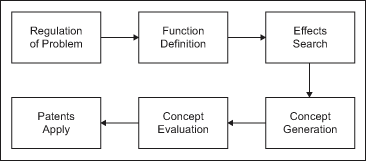 |
|
|
Problem regulation: The first step was to research the previous patents and study the existing five types of ink jet printer heads.
- Piezo by Philips
- Developed by Philips, Epson bought this technology and improved it. When a current flows on Piezo device, the ink is jetted by that device. (Figure 2, top)
- Thermal Jet by HP, Canon
- When a current flows on the heater, vapor pressure is created and pushes the ink. There are two types of this principle – thermal used by HP and bubble jet used by Canon. (Figure 2, middle, bottom)
- Magnetic frame by Samsung Electronics
- There is a magnet on one side of a cylinder that contains ink and the other side has an electric coil. When current flows on the coil, it turns into an electric magnet. The electric magnet pushes the cylinder and ink is injected.
- Electric spoon by LG
- A positive electric force charges on the ink and a negative electric force charges on an electrode. The ink being accelerated by one electrode is sucked in by the other.
- Electrolysis by an American venture company
- When a current flows on the ink, electrolysis is generated. The electrolysis generates gas in the ink and injects the ink.
Figure 2: Ink Jet
Printer Heads (Partial) |
| 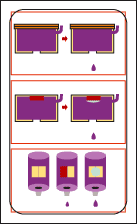 |
|
|
The ink jet printer head is, thus, defined as a device for liquid injection. The next step was to transform this problem into a standard problem; change the problem of the ink jet printer into a problem of liquid in a pipe.
Define function: How many methods exist for injecting liquid into a pipe? Usually two methods are possible: push or pull, as shown in Figure 3. How many ways can a liquid be pushed or pulled? Brainstorming initially suggested the following options:
- To pull: Straw, scoop, balloon
- To push: Piston, bomb, balloon
The next step was to survey the function and attribute of the moving liquid in pipe. The distance between the paper and the printer's head is short – it is only a few millimeters. The size of an ink droplet is extremely small – a pico liter. That means the ink droplets must travel a relatively long distance; injection pressure must be high to push the ink and have a fast operating time to inject the ink quickly.
| Figure 3: Liquid Moving in Pipe |
|  |
|
|
Use TRIZ effects: Using a software tool, the author developed an initial list of 221 effects and samples. A winnowed-down list of 45 follows: acoustic cavitation, acoustic vibrations, Archimedes' principle, Bernoulli's theorem, boiling, brush construction, capillary condensation, capillary evaporation, capillary pressure, Coanda effect, condensation, Coulomb's law, deformation, electric discharge, electro-capillary effect, electrocosmosis, electrophoresis, electrostatic induction, ellipse, evaporation, ferro-magnetism, forced oscillations, funnel effect, inertia, ion exchange, jet flow, Lorentz force, magneto-striction, mechano-caloric effect, osmosis, Pascal's law, resonance, shock wave, spiral, super thermal conductivity, super-fluidity, surface tension, thermal expansion of substance, thermo-capillary effect, thermo-mechanical effect, ultrasonic capillary effect, ultrasonic vibrations, use of foam and wetting.
Generate concepts: Using the 45 effects, the author generated concepts for a new ink jet printer head.
- Acoustic cavitation: ultrasonic waves irradiate the cylinder that holds liquid; bubbles develop in the liquid and the liquid is moved via those bubbles.
| Figure 4: Acoustic Cavitation |
|  |
|
|
- Bernoulli's theorem: Cylinder is connected into pipe and the air is blown into the pipe. Then the cylinder's pressure drops. The ink is sucked from the cylinder and the liquid moves by air.
| Figure 5: Bernoulli's Theorem |
| 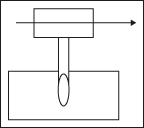 |
|
|
- Electric discharge: This phenomenon creates a shock wave from pressure in the liquid by an electric discharge. The flare of the discharge creates a high pressure in the liquid, with a necessarily fast operating time.
| Figure 6: Electric Discharge |
| 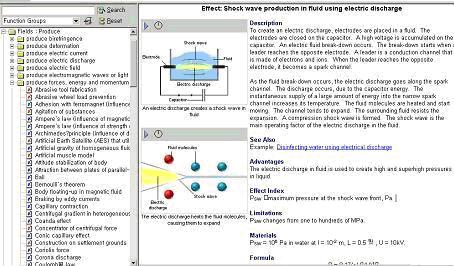 |
|
|
Evaluate concept: The author selected the most adaptive principle for a new ink jet printer head from the aforementioned 45 options – electric discharge.
Apply patent: Using selected concept, the author invented a new ink jet printer head and filed a patent based on the following claims.
This invention is a device for an ink jet printer head. A high voltage discharge in the liquid creates a high pressure that continuously injects ink. This printer head has a chamber of ink that contains symmetry electrode. When an electric current stored in a high voltage capacitor, flows, the flare of discharge breaks down the ink and ink is injected. This invention does not heat the ink, so there is little change to the ink; corresponding chamber damage from the high heat is weak.
| Figure 7: Patent No. 10-2003-0046441 |
| 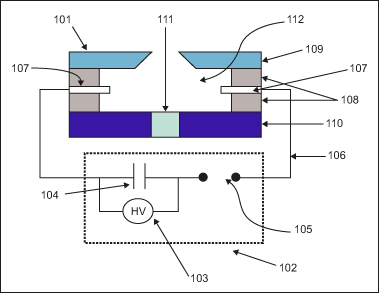 |
|
|
| Table 1: Other Effects Examples |
| Name | Description |
| Voltage-driven image device | Image device with electric resistance change, not electron charging like CCD or CMOS |
| Multi-layer solar cell | Effective chemical solar cell with multi-layers |
| Magnetic piston air gun | Air gun piston driven by electromagnetic force |
| Energy conservation electric motor | Energy conservation circuit for electric motor with PDP conservation circuit |
| Flat panel display | Flat CRT driven by electromagnetic force |
The author proved the ability of TRIZ to develop other inventions as described in Table 1. These results show the effectiveness of TRIZ for development of new products.
Conclusion
The usefulness of TRIZ is real, not an assumption, as shown by its use in developing the new ink jet head. If students/clients have no first-hand experience with TRIZ, they are likely to question the usefulness of TRIZ. TRIZ teachers must take some responsibility for how TRIZ is taught – it may be being taught at too high a level for beginners. Or perhaps a teacher is only teaching theory and not application. TRIZ education must develop a new model for applying TRIZ easily to use for teaching.
Acknowledgment
Thanks to Dr. Wonsik Kim for kind comments and editing.
References
- Mark Stefik, Barbara Stefik, Breakthrough: Stories and Strategies of Radical Innovation, HBR Press, 2002.
- Ik Cheol Kim, 40 Principles as a Problem Finder, The TRIZ Journal, March 2005.
- Ik Cheol Kim, "TRIZ as the New Product Concept Development Tool," TRIZ Symposium 2005.
- Ik Cheol Kim, "What Have to Make – New Product Development by TRIZ," Seoul: Intervision, 2006.
- Ik Cheol Kim, "On Problem," KTA, 2002.
Note to readers: This article was first published as part of the proceedings for 2007's Third TRIZ Symposium in Japan.
About the Author:
In 1996, Kim began working with TRIZ after being taught by Khomenko, Royzen, A. Narbut, Zlotin and Shulak. Since 1998, Kim has taught, and consulted with, TRIZ at Samsung. He has achieved MATRIZ Level 3 and published three TRIZ-related books. Contact Ik Cheol Kim at freeickim (at) hanmail.net.
Copyright © 2006-2011
– RealInnovation.com, CTQ Media. All Rights Reserved
Reproduction Without Permission Is Strictly Prohibited –
Request Permission
Publish an Article: Do you have a innovation
tip, learning or case study?
Share it
with the largest community of Innovation
professionals, and be recognized by your peers.
It's a
great way to promote your expertise and/or build your resume.
Read more about submitting an article.